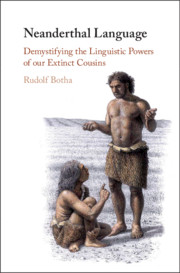Book contents
- Neanderthal Language
- Neanderthal Language
- Copyright page
- Contents
- Figures
- Images
- Acknowledgements
- Copyright Permission for Images
- Part I Preliminaries
- Part II Symbolic Behaviours
- 3 Making and Wearing Personal Ornaments
- 4 Producing Cave Art
- 5 Beautifying Bodies
- 6 Burying the Dead
- 7 Leaping to Language
- Part III Non-symbolic Behaviours
- Part IV Implications
- Notes
- References
- Index
3 - Making and Wearing Personal Ornaments
from Part II - Symbolic Behaviours
Published online by Cambridge University Press: 26 April 2020
- Neanderthal Language
- Neanderthal Language
- Copyright page
- Contents
- Figures
- Images
- Acknowledgements
- Copyright Permission for Images
- Part I Preliminaries
- Part II Symbolic Behaviours
- 3 Making and Wearing Personal Ornaments
- 4 Producing Cave Art
- 5 Beautifying Bodies
- 6 Burying the Dead
- 7 Leaping to Language
- Part III Non-symbolic Behaviours
- Part IV Implications
- Notes
- References
- Index
Summary
Chapter 3 unpacks the jewellery inference about Neanderthal language and appraises its soundness. Including three inferential steps represented by arrows, this inference looks in outline as follows: The Neanderthal occupants of the archaeological sites S1,…,Sn were associated with the objects O1,…,On → They wore these objects as personal ornaments → They treated these ornaments as symbols → They had language. [Sites S1,…,Sn include the Grotte du Renne and at least seven other caves/shelters. The objects O1,…, On include, inter alia, marine shells, raptor talons and feathers and perforated animal teeth.] With reference to a large literature, Chapter 3 finds the following about the soundness of the jewellery inference: (a) the data from which the first inference starts provide adequate empirical grounding for it; (b) this step is warranted by an accepted theory of the distinctive propeties of personal ornaments; (c)the second step is unwarranted: it is not underpinned by an adequate theory of the distinctive properties of symbols as opposed to other signs. This finding implies that the third inferential step lacks the necessary grounding.
- Type
- Chapter
- Information
- Neanderthal LanguageDemystifying the Linguistic Powers of our Extinct Cousins, pp. 33 - 68Publisher: Cambridge University PressPrint publication year: 2020

